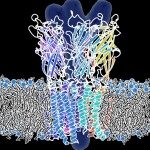Link to Pubmed [PMID] – 18820239
Link to HAL – Click here
Link to DOI – 10.1529/biophysj.108.131649
Biophys. J. 2008 Dec;95(12):5587-605
We describe a new way to calculate the electrostatic properties of macromolecules that goes beyond the classical Poisson-Boltzmann treatment with only a small extra CPU cost. The solvent region is no longer modeled as a homogeneous dielectric media but rather as an assembly of self-orienting interacting dipoles of variable density. The method effectively unifies both the Poisson-centric view and the Langevin Dipole model. The model results in a variable dielectric constant epsilon(r) in the solvent region and also in a variable solvent density rho(r) that depends on the nature of the closest exposed solute atoms. The model was calibrated using small molecules and ions solvation data with only two adjustable parameters, namely the size and dipolar moment of the solvent. Hydrophobicity scales derived from the solvent density profiles agree very well with independently derived hydrophobicity scales, both at the atomic or residue level. Dimerization interfaces in homodimeric proteins or lipid-binding regions in membrane proteins clearly appear as poorly solvated patches on the solute accessible surface. Comparison of the thermally averaged solvent density of this model with the one derived from molecular dynamics simulations shows qualitative agreement on a coarse-grained level. Because this calculation is much more rapid than that from molecular dynamics, applications of a density-profile-based solvation energy to the identification of the true structure among a set of decoys become computationally feasible. Various possible improvements of the model are discussed, as well as extensions of the formalism to treat mixtures of dipolar solvents of different sizes.

